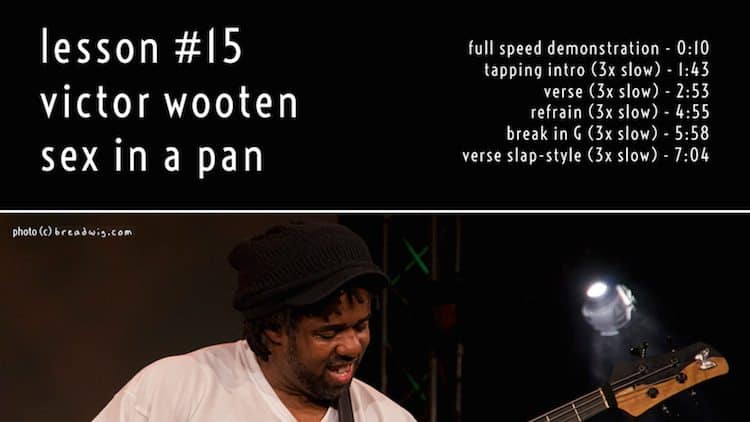Bass Edu
Victor Wooten’s Sex in a Pan

A full tutorial on Victor Wooten’s Sex in a Pan!
Anybody who does not know Vic? Okay… So you have also read my report on Vic’s Workshop and now you’ll see a full tutorial on Sex in a Pan, one of my favorites from him. Instead of making more short videos, now I decided to make one longer vid and break down the major parts of the whole song – so here it is! Enjoy it!
This song reflects the natural playfulness and the joyful wisdom of Vic himself while really making your ass move to it… it is THE flow 🙂 To be honest, while the song is quite techincal in a way, I cannot really think (or talk) about it that way, it is more like a feeling : )When you first try to play it, it will feel like juggling – coordinating all the fingers together to make it flow and feel good takes some practice but the more you do it, the more you enjoy it, and the better you play.
Trust me, learning this piece is a real therapy experience 🙂 The therapy includes little tapping, playing chords and double-stops, using dead, muted and accented notes, using that many fingers on your hands you never used before, intense left hand hammering, light slapping with double-thumbing.
The intro… besides the big stretch and the sliding right hand middle finger tap, there is one more thing to the intro part: the harmonics are hard to get when you release the right middle finger – your left hand has to fret two notes and just hover over some notes on the G string so lifting your right middle finger will produce the desired harmonic note… so it is kind of tricky, Vic magically brings them ringing everytime but well, if you can live without it just do so 🙂
The verse… the fun part. All of it is played sort of palm muted, for that, just place the side of your hand towards the bridge and play like that.When you play this groove, think of space and let the open strings breath and when your left hand has to hammer that 7th fret on the E string – be gentle and do not choke that open string too early. Otherwise – happy jugglin with all your fingers 🙂 On the notation – P means the thumb, I means the index finger, M means the middle finger, T means right hand tap. On the left hand: 1 means left hand index, 4 means left hand pinky and when you can see those, usually you do not have to pick that note with your right hand!. Hope you can sort it out while watching it 🙂
The refrain… further finger coordination, and sliding double-stops. In the tab, you can see rest after the first slide, but note that there is a rhytmic right hand tap on the vide – I have seen Vic play that live sometimes.
The break in G… another fun part – I am still trying to figure out the descending pattern that Vic does recently but until then, here is how I think he played it on the record. Not as many right hand slap as you would think – that’s a good left hand finger-strengthener with the hammer-ons 🙂
So, if you reached that level, you are ready for the last part, the slap-style variation on the verse: if you watch Vic live, this part is played with a very light slapping-thumbing sort of playing – note that on the G and D string he uses double-thump style slapping while on the E and A string he only goes down with his thumb – it is barely slapping and it is a very natural motion – remember the economy of motion that all those pro players talk about!
So that’s it: if you have further questions, just shoot in the comments!
The video does not intend to violate any laws or copyrights, it is to be used for educational purposes (fair use). The original song is available for purchase and listening at:
https://itunes.apple.com/us/album/greatest-hits-20th-century/id358187446
Visit Vic’s site and support him!
For members, here is the GuitarPro5 file!
Bass Edu
BASS LINES: Triads & Inversions Part I

Triads & Inversions Part I…
Hello bass players and bass fans! In this issue, we are going to study the triads and their inversions.
It is very important for all bassists to understand and master the triads, but it is even more important to understand their different inversions.
In Part I, we are going to learn what the triad is in fundamental position.
The Formula consists of root, third and fifth.
Degrees of the Triad
Major Triad: 1 – 3 – 5
Minor Triad: 1 – b3 – 5
Diminished Triad: 1 – b3 – b5
Augmented Triad: 1 – 3 – #5
Fig.1 – The C, Cm, Cdim & Caug triads
(Fundamental Position)

Bass Edu
Premiere! Bass Playthrough With Foetal Juice’s Bassist Lewis Bridges – From the Album, Grotesque

Premiere! Bass Playthrough With Foetal Juice’s Bassist Lewis Bridges – From the Album, Grotesque
Bassist Lewis Bridges Shares…
“Gruesome’s sparse intro marks a stark contrast from the intensity of the rest of the album. The original intention was to keep the bass simple but colourful, however as I worked on it, the lines grew more expressive and the more striking flourishes began to emerge. The intensity builds into a harmonic minor passage that takes us into the drop — a signature death grind cacophony. This is where Foetal Juice thrives. You’re getting a full-on right-hand barrage to in the face to take you into a groove-laden mulch-fest.
I owe my throbbing bass tone to the Darkglass Alpha Omega pedal borrowed from our sound engineer, Chris Fielding (ex-Conan), mixed with the clarity of the tried and true Ampeg SVT CL.
As mentioned earlier, colourful basslines are important, especially in a one-guitar band. Chucking some funny intervals and odd flourishes here and there brings life into the brutality. There’s no point sounding brutal if it’s not gonna be fucking evil too!
Recording this playthrough was hard work. This was not the fault of James Goodwin (Necronautical), who was kindly filming and is ace to work with, but because in true Foetal fashion, we had stinking hangovers — and that jam room was hot!”
Follow Online
FB @FoetalJuice
TW @FoetalJuice
IG @foetaljuice
Youtube: @Foetaljuice
Spotify
Foetaljuice.bandcamp.com
Bass Edu
Bass Lines: The Circle

Bass Lines: The Circle…
Hello bass players and fans of bass! This month we’re going to study “The Circle.”
The Circle of Fourths can also be called “The Circle of Fifths or just The Circle.
Practicing the scales, chords, and ideas in general via the circle has been a common practice routine for jazz musicians and highly recommended.
It is a disciplined way of working through all twelve keys.
Plus, many bass root movements to jazz and pop songs move through sections of the circle.
Fig. 1 – “The Circle”

See you next month for more full bass attack!
#bassmusicianmag, #basslines, #bmmbasslines, #groovemaniac, #thecircle, #thecircleoffourths, #thecircleoffifths,#scales & #chords.
Bass Edu
Approach Notes – Part 5

Continuing our lesson of Approach Notes, Part 5…
In continuing with the concept of approach notes being applied to chord tones, this lesson approaches the root, third, fifth, and seventh degree of each arpeggio inversion by incorporating a double chromatic approach from above, and a single chromatic approach from below.
The first examples approach the root of a G major 7th arpeggio as a double chromatic from above and a single chromatic approach from below -before continuing to the third, fifth, seventh, double chromatic from above/ single from below to the root, continue to the third, fifth, and come back down.

The next example approaches the first inversion of G major 7th arpeggio.
A double chromatic from above/ single from below approaches the third, continue to the fifth, seventh, root, double chromatic from above/ single below to the third, continue up to the fifth and seventh, and back down.

The third example approaches a second inversion of a G major arpeggio.
A double chromatic from above/ single from below approaches the fifth, continue to the 7th, root, 3rd, double chromatic from above/ single from below to the 5th, continue to the 7th, root, and back down.

This final example approaches a third inversion of a G major 7th arpeggio.
A double chromatic from above and below approaches the 7th, continue to the root, 3rd, 5th, double chromatic from above and below to the 7th, continue to the root, 3rd, and back down.

Be sure to pace yourself with these lessons to avoid burning out.
Being overly ambitious with your practice schedule can lead to unrealistic expectations. Try learning one approach note concept and one chord type a week. Change your practice routine as necessary and tailor it to your needs as a musician. Good luck!
Bass Edu
BASS LINES – The Blue Notes (Minor Blues Scale)

Hello bass players and bass fans! Happy New Year 2024!
In this issue, we are going to study the blue notes.
In blues, jazz, and rock, a blue note is a note that (for expressive purposes) is sung or played at a slightly different pitch from standard. Typically the alteration is between a quartertone and a semitone, but this varies depending on the musical context.
The blue notes are usually said to be the lowered third(b3), lowered fifth(b5) and lowered seventh(b7) scale degrees. The lowered fifth(b5) is also known as the raised fourth(#4). Though the blues scale has “an inherent minor tonality, it is commonly ‘forced’ over major-key chord changes, resulting in a distinctively dissonant conflict of tonalities”.
Blue notes are used in many blues songs, in jazz, rock and in conventional popular songs with a “blue” feeling.
Formula:
The A Minor Blues Scale
1 – b3 – 4 – (#4/b5) – 5 – b7
A – C – D – (D#/Eb) – E – Bb
The grades(blue notes):
b3, (#4/b5), b7
C, (D#/Eb), Bb
See you next month for more full bass attack!
#bassmusicianmag, #basslines, #bmmbasslines, #groovemaniac, #thebluenotes, #minorbluesscale & #bluesscale






















